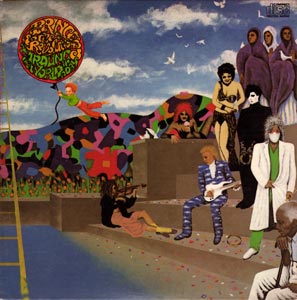
Around the World in a Day (1985)

1. Around the World in a Day
2. Paisley Park
3. Condition of the Heart
4. Raspberry Beret
5. Tambourine
6. America
7. Pop Life
8. The Ladder
9. Temptation
It’s hard to say exactly when Prince began morphing from a brilliant, genre-hopping musician into a full-blown enigma, but this album is as good a place to start as any. By the mid-‘80s, he had already conquered the world with Purple Rain, and rather than ride the wave of that triumph, he took a hard left turn no one saw coming. Around the World in a Day arrived less than a year after Purple Rain, with zero buildup and barely any promotion. And what the fans got was something... different. Really different.
This was the first true curveball in a career that would eventually be defined by them. From here on out, trying to predict Prince’s next move was a fool’s errand. He’d go on to rename himself after an unpronounceable glyph, release albums exclusively online before that was even a thing, and carve the word “slave” into his own face. And maybe, just maybe, it all started right here—with a record that left a lot of people wondering what on earth had happened to the guy who brought us Let’s Go Crazy.
But as with so many of Prince’s more idiosyncratic moves, time has done wonders for Around the World in a Day. At the time, it may have felt like a deliberate sidestep—or even a rejection—of commercial success. But today, it stands as one of his most ambitious, colorful, and curiously joyful experiments.
Trying to slap a genre label on this one is a bit like trying to staple jelly to a wall. The word “psychedelic” gets thrown around a lot, and sure, there are clear echoes of late-‘60s sunshine pop and paisley-shaded whimsy. But that only scratches the surface. Prince may have drawn inspiration from the Summer of Love, but he wasn’t interested in cosplay—he was building something new. Raspberry Beret and Pop Life were the obvious singles, and they hold up remarkably well as breezy, candy-coated earworms. But even those tracks feel a little off-kilter, a little weirder than their chart positions suggest. In anyone else’s hands, they probably would’ve been considered curiosities. With Prince, they were hits.
The hidden gem here is Paisley Park, a track so sunny and effervescent it practically floats. It would later lend its name to Prince’s personal studio complex, his label, and eventually, the mythology surrounding the man himself. Why it was never a U.S. single is a mystery—it did get released in the U.K., where it fared modestly well. The opening title track, Around the World in a Day, is cut from the same silk: dreamy, exotic, full of Eastern-tinged instrumentation and childlike wonder. For an album that caught everyone off guard, it’s surprisingly accessible once you give it a little breathing room.
Elsewhere, the mood shifts. Tamborine throws in some classic funk strut, like Prince giving a nod to his earlier self while still pressing forward. Condition of the Heart is one of the stranger inclusions—a delicate, theatrical piano ballad that wouldn’t feel out of place in an Andrew Lloyd Webber musical. And then there’s The Ladder, a sweeping spiritual piece that feels like Purple Rain’s quieter, less showy cousin. It doesn’t reach the same emotional peak, but it aims in that direction and lands in a pretty satisfying spot.
The real head-scratcher is America. Equal parts funk jam and protest anthem, it takes the melody of America the Beautiful and turns it into a relentless, drum-pounding groove that barrels forward like a runaway train. The lyrics are muddled, but the energy is unmistakable. Prince was never one to hit you over the head with a political message—he’d rather let the music do most of the talking. And in that regard, it works.
Unfortunately, the record closes with a thud. Temptation starts promisingly enough—moody, slow-burning, full of that classic Prince sleaze—but then things go sideways. Around the five-minute mark, he veers into a bizarre dramatization involving God, sex, and a saxophone that sounds like it's being tortured. There’s screaming, there’s caterwauling, there’s a lot of “acting.” And it just keeps going. If ever there were a track that begged for an early fadeout, it’s this one.
Still, even with its oddball misfires and jarring tonal shifts, Around the World in a Day is a fascinating listen. If anything, it’s guilty of ending too soon—several songs seem to vanish just as they’re getting somewhere. But that’s kind of the point. Prince wasn’t aiming to give you neat little radio-ready packages here. He was stretching out, indulging his whims, and showing that he didn’t particularly care what anyone expected of him.
He would take bigger, bolder risks later in his career, but this was one of the few times he made a hard left turn and still landed squarely on his feet. It may have baffled listeners in 1985, but in hindsight, it’s clear: this wasn’t Prince losing the plot. It was Prince rewriting it.
Go back to the main page
Go to the Next Review